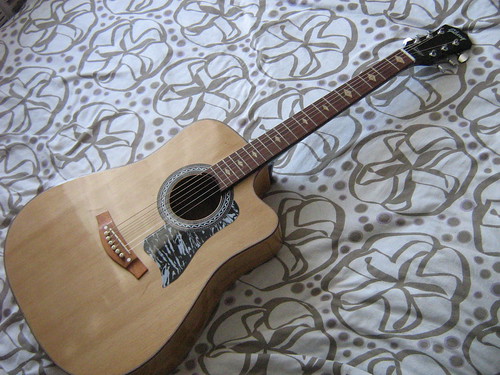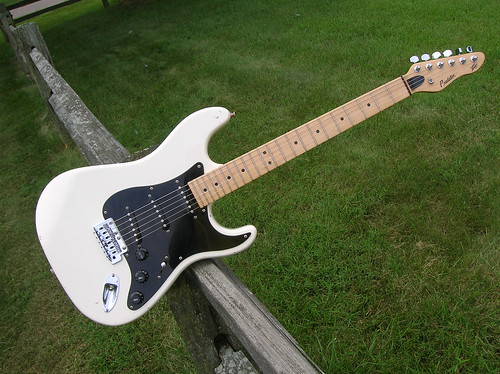Classical Guitar
---------------

What you see above is just an example of what a typical classical guitar looks like. It has 6 strings and the main feature of the classical guitar is the fact that it uses nylon strings. Most of the time, the classical guitar does not come with a plug-in feature. The benefit of having a plug-in classical guitar would be that you can use it for performances to large audiences. However, if your classical guitar does not have a plug-in feature, you can still use it for performances, all you need is to put a microphone near the sound hole to amplify the sound. Classical guitars are usually used for instrumental pieces and Spanish pieces.
You can listen to a sample of how a classical guitar sounds here.
Acoustic Guitar
----------------

Above is an example of what an acoustic guitar looks like. Like the classical guitar, it has 6 strings, however the major difference is that it uses steel strings. Acoustic guitars come both with normal and plug-in features. Like I mentioned above, there are advantages to having a plug-in acoustic. In the same way, if you do not have a plug-in acoustic and wish to use it for performances, all you need is a microphone positioned at the sound hole. Alternative, you could have the plug-in installed. However, this might affect the overall sound of your acoustic guitar. Acoustic guitars are usually used in most contemporary songs on the radio.
You can listen to a sample of how an acoustic guitar sounds here.
Bass Guitar
------------

Above is an example of how a bass guitar looks like. It usually has 4 strings (sometimes 5 or 6), and it uses steel strings as well. The gauge (size) of the bass guitar strings is really high (big). I'm sure you can tell how thick it is by looking at the picture. The 4 strings represent the 4 bass notes of the normal 6-string guitar. They are E A D and G. All bass guitars have to be plugged-in because if you don't, no sound can be heard when you play it. Notice how it does not have a sound hole when compared to the classical and acoustic guitar. The bass guitar in my opinion, is a very important instrument in a band because it gives drive and groove to songs. In songs, the bass guitar can identified by listening to the lowest notes.
You can listen to a sample of how a bass guitar sounds like here.
Electric Guitar
---------------

Above is an example of how an electric guitar looks like. It has 6 strings and it uses steel strings. Even though it uses steel strings like the acoustic guitar, it would be recommended to by electric guitar strings (they're written on the set when you buy them). As with the bass guitar, the electric guitar does not have a sound hole as well, so it has to be plugged into an amplifier or it will produce no sound on its own. Electric guitars are usually used with effects. These effects come in the form of effects pedal. What you do is to connect your guitar to the effects pedal, and then the effects pedal to the amplifier. This will give the electric guitar the ability to make a lot of different sounds. The most common would be the distortion.
You can listen to a sample of how an electric guitar (with distortion effects) sounds like here.
12-String Guitar
-----------------

Above is an example of a 12-string acoustic guitar. As its name suggests, it has 12 strings, and since it's an acoustic guitar, it uses steel strings as well. There are also 12-string electric guitars too. Since it's such a special type of guitar, it has its own set of strings which comes with all 12 strings, so there's no way you can get the wrong strings for this guitar (unless you buy the electric ones). I personally don't have much experience handling this guitar at all, but I know the sound it produces is bright and actually really nice to listen to. It is also much harder to play this guitar because of the fact that it has 12 strings. Imagine having to pluck the right string!
You can listen to a sample of how a 12-string acoustic guitar sounds like here.
Alright, that was just a short description of the different types of guitars out there. I'm sure they're more but i'll just stick to these 5 kinds. I hope it was informative to all who are reading this.
9 comments:
I'd like to know your opinion..what kind of guitar is better to start with for a beginner? is it the classical / accoustic?
what factors do u consider first before choosing?
thx in advance.
i would suggest to perhaps start with a classical guitar because the nylon strings are less painful the the fingers.
but i heard people say that electric guitars are the best to start out with cause the strings are easier to press.. is this true?
hi Kevin,
usually, people say the electric guitar is easier to press because the action for electric guitars are pretty low.
for a beginner, the classical guitar is still the better choice because it's much cheaper, and you don't need an amplifier to project the sound. The electric guitar on the other hand, needs an amplifier so that you can hear what you are playing
Hi, wanna noe what is the difference for the sound or the function btw acoustic & electro-acoustic? does sound brighter for electro acoustic?
Hi Anonymous, I'm not sure I have heard for the term electro-acoustic before but I am assuming you are referring to an acoustic guitar that can be plugged into an amplifier. If that is correct, then you are referring to a plug-in acoustic.
The difference between a plug-in acoustic and a normal acoustic is that it can be plugged into an amplifier to amplify the sound. The function of this would be for performances.
I loved the post by the way, i have just started learning myself how to play. I was wondering how difficult it would be to record loops and samples into song i have written. Could you give me some advise were i should start?
hi HarisionC87,
I'm glad you have found the post to be useful. Unfortunately, I do not know about loops and samples. Sorry, can't help you there.
According to me you should have to use the guitar which is flexible for the finger until you don't get completeness about the guitar, i think that is really useful for you.
Electro Acoustic Guitar
Post a Comment